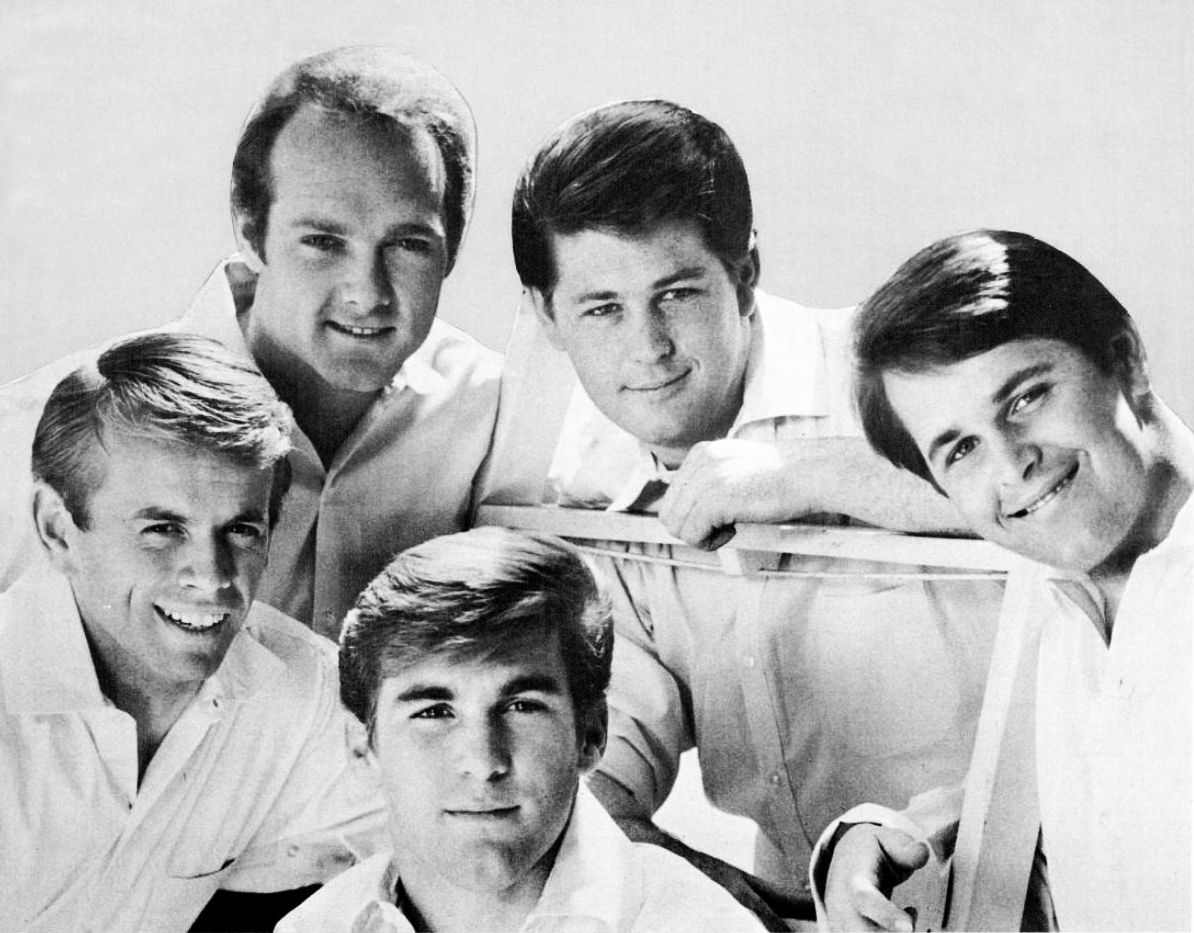
Dan Gorman: Recently, with some warmer weather on my mind, I found myself on a bit of a Beach Boys kick. While creating myself a playlist of underrated Beach Boys tunes on Rdio (mostly from the post-Smiley Smile era), a friend reached out and tipped me off to a project he had run on the site a few years back.
Over the course of a month, he and many others listened to one Beach Boys album a day and discussed the band within a handful of playlists they had created. After reading through the discussions, I reached out and asked if I could add my own thoughts while also editing and combining all the dialogue into one, chronological blog post.
The result is what we have below, a guided tour through (most) of the band’s discography, with all quotes and stories attributed to the original Rdio users. Thanks to Dave Roberts for spearheading the original project, as well as giving the first go-ahead to my attempt to get all this great stuff in one place.
Thanks as well to Jon Springer, Uncle Wayne, user CY*, and others. Also: click on the album titles to hear a song from the album.
It’s a big undertaking, so let’s get started:
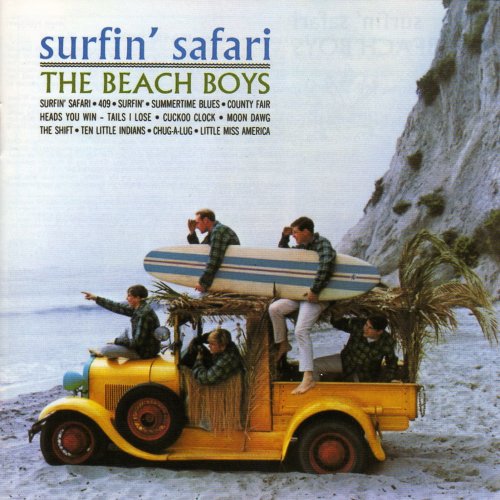
1. Surfin’ Safari (1962)
Dave Roberts: The Beach Boys’ debut album derives from demo-audition tapes that Brian Wilson produced, which his dad (Murray) sent to Capitol Records in 1961.
“Surfin’” was released on Capitol’s budget label (Candix) in November 1961, and soon became a regional hit. The “Surfin’ Safari” single (b/w “409”) was released on the big label and rode the national charts through the summer of 1962.
That’s when the Beach Boys captured this nine year old kid’s imagination for life.
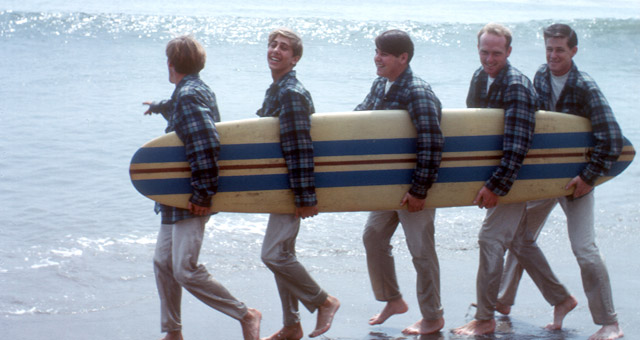
Dan Gorman: Where it all began – interesting to read that on the liner notes they refer to their harmonizing style as “unusual” – especially now that their style has been aped and parodied to death.
Aside from the singles, which you’ve all heard plenty by this point, there’s not too much of interest here, personally. “Cuckoo Clock” is cute, and the surf-strumental riffs of “Moon Dawg” are a nice change of pace.
CY*: On “The Shift”, one probably assumes the boys would be singing about a car part – nope, they are singing about a piece of woman’s clothing, which now has made a come back!
Dave Roberts: Pop albums in the early sixties were generally comprised of one or two hit singles and, the rest: filler. The Beach Boys’ early albums were no exception – however, I do enjoy hearing the first rudimentary sounds of what would become an indelible musical statement.
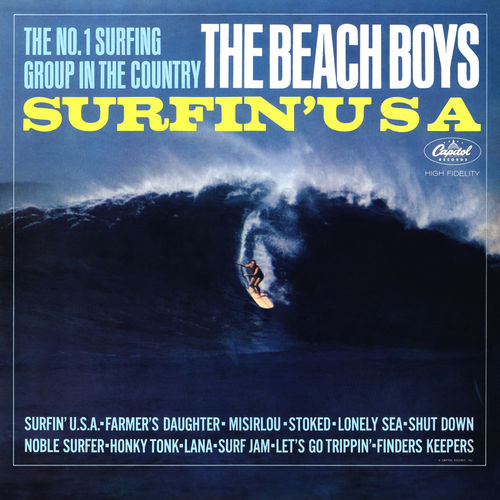
2. Surfin’ USA (1963)
Dave Roberts: Surfin’ USA shows Brian Wilson gaining confidence in songwriting and arrangements; for the first time, vocals are double-tracked to achieve the defining Beach Boys sound. The song “Farmer’s Daughter” was later covered by Fleetwood Mac! The wistful feel of “Lonely Sea” will be carried through songs like “Caroline No”, “’Til I Die” and the recent “Summer’s Gone”.
The album reached #2 and remained in the charts for over 70 weeks; unleashing the surfin’ craze nationwide.
Uncle Wayne: As someone who was only familiar with the hits on these early albums, I gotta say that “Lonely Sea” is a revelation! Although, I could do without the spoken word part.
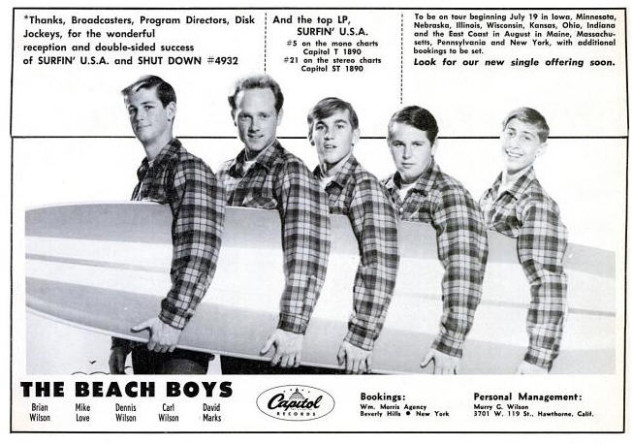
CY*: “Lonely Sea” is one of the first Beach Boys songs to really give out emotion to the listener; a heartbreaking vocal and feel, and a wonderful song. Hence, one sleeper most folks probably have overlooked, understandably, for this is the beginning of one amazing career.
Dan Gorman: Have to agree about “Lonely Sea” – plus, there’s something about how their early work so rigidly conformed to the surf-n-summer themes that makes this one intriguing – molding that theme of a lonely sea to relationship woes just seems apt and engaging.
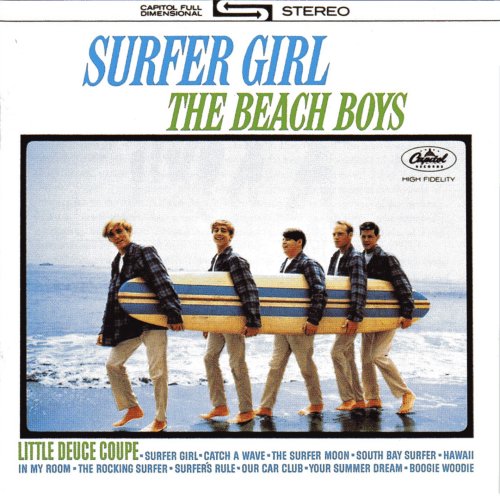
3. Surfer Girl (1963)
Dave Roberts: Even though he’d been doing it all along, this is the first album that Brian received full producing credit. It’s also the second of three albums that the Beach Boys released in 1963. Which may explain the high rate of filler. Yet, there are gems and oh what gems they are: “Surfer Girl”, “Catch A Wave”, “In My Room” and “Summer Dreams”.
Brian wrote his very first song, “Surfer Girl”, back in 1961 – it’s a classic american standard that I’ll never tire of. After this album, Beach Boys’ songs moved inland with Little Deuce Coupe and then, inward with more personal themes. Except for a handful of songs that were nostalgic (“Do It Again”) or longing for the past (“Surf’s Up”) we would rarely hear surf-themed music again.
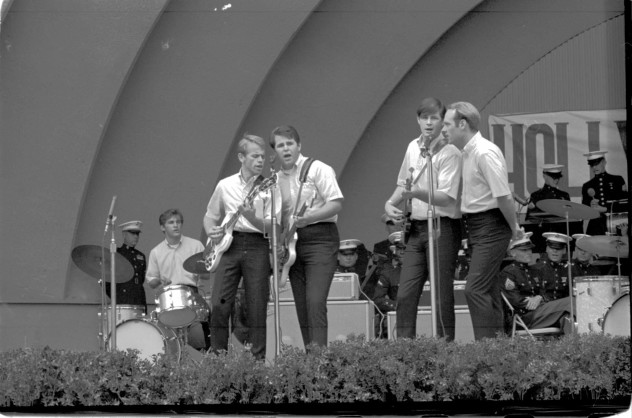
CY*: “In My Room” is pretty much the most fully developed song on Surfer Girl; pure and simple, a timeless wonder. Brian Wilson co-wrote the song with pal Gary Usher, and sets down a heartbreaking melody and vocal line with a personal, touching lyric.
Dan Gorman: Here’s where they start to really work on their sound – aurally, outside of songwriting, I mean. Things are starting to take shape, production wise, and the slow-dance of lead-off title-track “Surfer Girl” stands head-and-shoulders against similar slow numbers from the previous records.
As mentioned already, they were pushed by the label for more and more content during this era, so there’s definitely some low-points on here, quality wise.
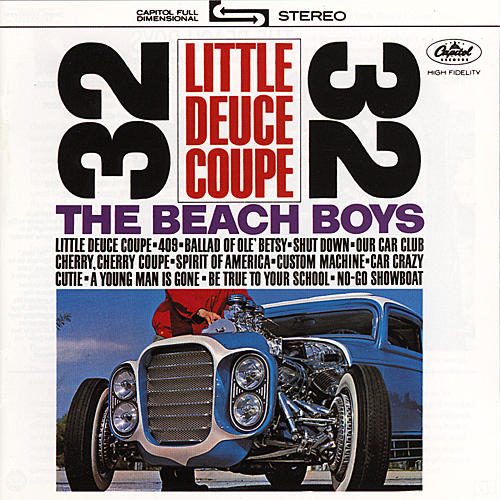
4. Little Deuce Coupe (1963)
Dave Roberts: The first Beach Boys concept album? Hardly. Just a group of songs (some pretty trite) celebrating America’s love/obsession with the automobile. “Shut Down”; best car song they ever did. “A Young Man Is Gone”; a tribute to James Dean by way of The Four Freshmen.
CY*: Did you realize only 30 days lapsed between the recording of Surfer Girl and Little Deuce Coupe? Now, some bands take almost a year between albums. This was their third studio album in the year 1963!
Dave Roberts: Capitol was going to stitch together their own Beach Boys car compilation without Brian’s permission so he rushed ’em the Deuce album. As if there wasn’t enough pressure already, with touring and the dreaded Father Murray on his back.
Jon Springer: Even though it was a popular thing at the time, the notion of a “concept album” about hot rods is impossibly quaint today, but I love the earnestness of the whole Little Deuce Coupe thing, even with several recycled songs. Mike Love imagined himself as a real hot-rodder, and as a result Brian had lots of authentic lingo to jam into the songs. It’s also not too cool to capture real emotion in a eulogy for a dead drag-racer, and it’s aware enough to recognize the symbolism inherent in a speed record “rocket car” named Spirit of America.
Teen rhythm guitarist David Marks is pictured on this record but was out before any new stuff was recorded. He quit during the summer tour after being badgered by Murray’s admonitions to smile when he played.
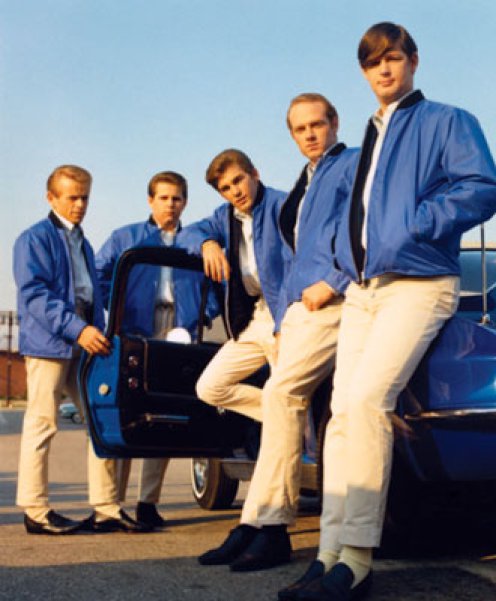
Dan Gorman: I feel like a theme begins here, with The Beach Boys making some real headway, artistically on an LP (Surfer Girl, Today!, Pet Sounds) only to suffer some kind of setback or label-interference, resulting in a rush job as follow up (Capital threatening to put together their own car-comp leading to Little Deuce Coupe, Party! emerging to appease the label for the holiday season pre-Pet Sounds, and Smiley Smile in the wake of the Smile debacle).
Not to say that this feels rushed, or is a misfire, but with high hopes after Surfer Girl, I could have used some more forward-thinking tracks.
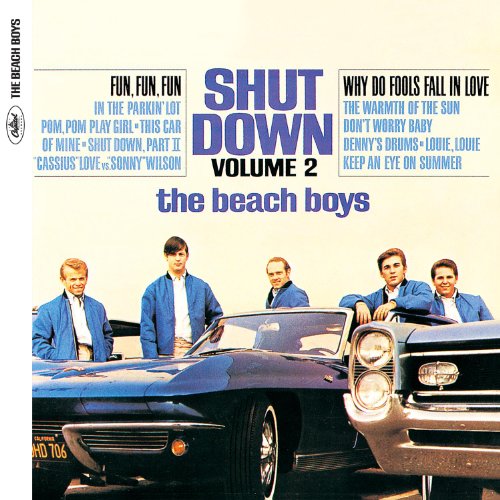
5. Shut Down Vol.2 (1964)
Jon Springer: Shut Down Vol. 2 is another “car” album and like Deuce Coupe, there are moments when the music is as visceral and sexy as the the contours of a Corvette. Any goofy filler ought to be forgiven by residing on the same disc as the extraordinary “Don’t Worry Baby” (maybe the greatest car song ever) and “Warmth of the Sun.” “Fun Fun Fun” is also, um, fun.
Dave Roberts: I was 11 years old in 1964, and had a sweet singles collection plus a handful of albums. Two I owned from that year were Meet The Beatles and Shut Down Vol. 2. It’s always a kick from beginning to end, even with the clunkers and an absolute stinker (see: “‘Cassius’ Love Vs. ‘Sonny’ Wilson”).
“Don’t Worry Baby” starts as a homage to The Ronettes‘ “Be My Baby”, before transcending into the saga of an angst-ridden young man who finds comfort in the love and understanding of a woman; Brian’s wall of vocals here are perfection.
“The Warmth Of The Sun” was written on the evening of John Kennedy’s assassination. Brian began the chord structure, called Mike Love to hurry over and they completed the song that night. Mike’s best lyrics are set to Brian’s hauntingly moving melody.
The country reeled after the president’s murder. The Beatles and The Beach Boys would continue to produce their positive art – and we followed the beat.
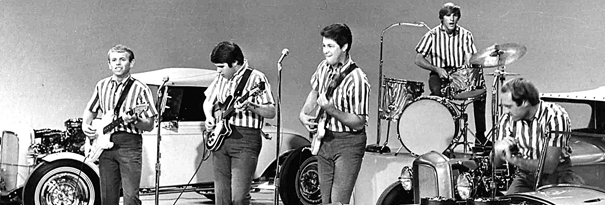
Uncle Wayne: It’s enlightening hearing how important this band was to Americans in the early to mid sixties. I was a Canadian Air Force brat, stationed in France and Germany during most of the 60′ – so my musical influences were very Anglo oriented. In that world, the Beach Boys were no more prominent than The Four Seasons.
It also seems like Brian has just been coming to grips with the talent and genius he possesses, and doesn’t always know just what to do with it. The rest of the band are really just (vocal) instruments at his disposal – I’m not sure that they appreciate the brilliant situations Brian is occasionally putting them in.
And “Don’t Worry Baby”, what an awesome song! Apparently even Brian didn’t realize what he had created here – it was the B-side of a single, title buried on the cover, well under the headlining “Fun Fun Fun” and “Why Do Fools”.
I’ve never listened so closely to this, but repeated listens with the headphones bring new revelations each time. I love the way he doesn’t pronounce the “t” in “out alright”.
Dan Gorman: Ditto to everything in regards to how wonderful “Don’t Worry Baby” and “Warmth of the Sun” are.
On this LP though, there’s a real push-and-pull between the filler and the quality – the aforementioned “‘Cassius’ Love Vs. ‘Sonny’ Wilson” foreshadows those “goofing around in the studio” tracks that are to come, and the record ends with two full minutes of Dennis drumming, instrumentally.
But, when you hear the vocal arrangements working beautifully in stereo on “Keep An Eye On Summer”, you realize why their early records had so many songs that felt like copies of one another – I can only assume they were chasing that magic with every track.
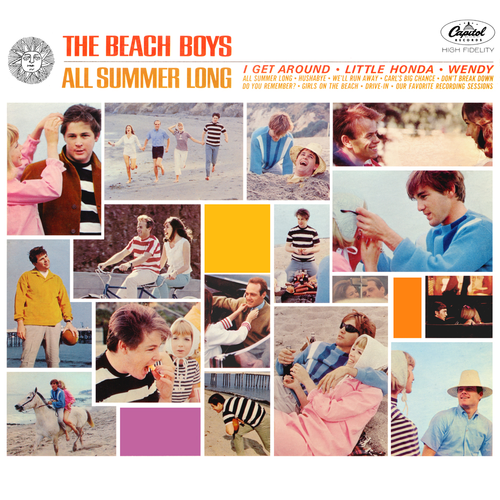
6. All Summer Long (1964)
Dave Roberts: During the heaviest surge of the British Invasion, The Boys released this, their most solid effort to date. It reached #4 and remained on the charts for over 70 weeks. The single, “I Get Around” went straight to #1 on, appropriately, July 4, 1964. Take that, Brits!
Except for the obligatory ‘fun in the studio’ track (a conceit they would mercifully abandon after the Today! album), this album rules.
Uncle Wayne: The title track is great – I love the tempo/momentum thing going on here. “Wendy” is also a treat (cough and all).
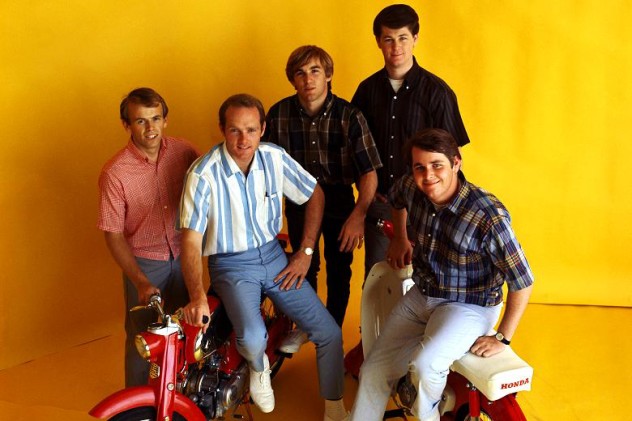
Dan Gorman: Maybe it’s just me, but this LP is the first time I noticed any true structure experimenting going on in their songwriting chops – “I Get Around” jumping from hook-to-hook, with subtle instrumentation change-ups really sounds revelatory in comparison to a few of their previous records. All Summer Long seems to be where their sound truly makes some major jumps. As a side note, Descendents do a killer cover of “Wendy!”
Dave Roberts: Check-out the underrated tracks “Little Honda”, “We’ll Run Away” and “Don’t Back Down”. All Summer Long marks 6 Beach Boys albums in 2 years – amazing.
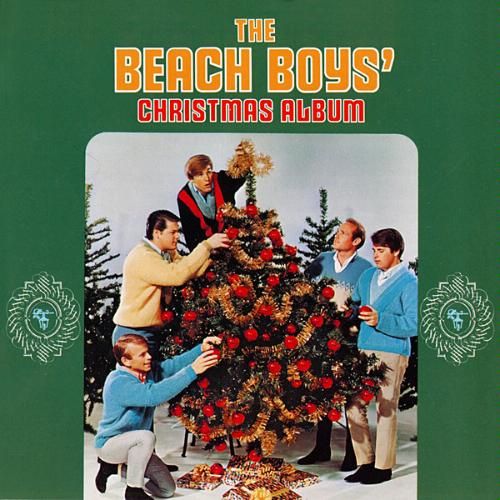
7. The Beach Boys’ Christmas Album
Dave Roberts: Not a big fan of Christmas music, so I’ll give this the once over and move on. The first 5 songs are originals produced and arranged by Brian, and the remaining standards are arranged by Dick Reynolds who worked with Brian’s idols, The Four Freshman.
Dan Gorman: I’ve actually become something of a sucker for oldies Christmas tunes in the past few years, so this is sounding pretty good to my ears right now – even in March. It’s actually a decent segue between All Summer Long and Today!, and the originals are at least worth a look to hear their studio prowess evolving.

8. Today! (1965)
Dave Roberts: In December 1964, while flying to a gig in Arizona, Brian Wilson suffered an acute anxiety attack. Two weeks later, he informed the rest of the group that he would no longer go on tours and, instead, work in the studio on their new music. And for the next 2 years, Brian’s creativity and genius for melody, harmony, arrangement and production excelled to an unequaled degree.
With backing tracks provided by the famous Wrecking Crew, Brian would build the songs piece by piece and take after take until they mirrored what was in his head. Then he brought in the other members of the group to add that warm, indelible nuance.
While the A-side of Today! is sunny and upbeat, the B-side is ethereal and introspective – pointing the way to Pet Sounds. Paul McCartney has said that when he and John first listened to Today! album, they both realized they needed to “up their game”. The result? Rubber Soul.
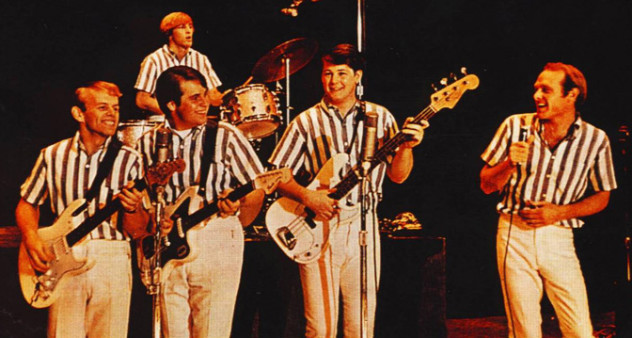
Jon Springer: Today! showed a real step forward musically, particularly by the somber end of the record – it resembles what we’d be hearing on Pet Sounds.
There’s a lot of great stuff here but going with “When I Grow Up” as it contemplates a future with wide eyes, including the signature surf guitar sound but now in support of a harpsichord, and of course lethal harmonies. One of the fun things I’ve been doing is trying to identify the lead vocalists as I listen – “Rhonda” throws you for a loop as its Al Jardine‘s first lead.
CW*: Today! is sheer quality. Of course I’m totally loving the second half, but you can’t overlook “Good To My Baby” and “Don’t Hurt My Little Sister” are hugely underrated up-tempo Beach Boys songs, and very very catchy.
Uncle Wayne: Not sure how I got to where I am without knowing about the whole side 2 of Today! thing – cool!
Dan Gorman: In my eyes, Today! is probably the first legitimately fantastic Beach Boys record – from top-to-bottom. Totally free from the shackles of the surf/summer/car themes, they’re able to cast a bit of a wider net, thematically. It definitely sounds more along the lines of what would come later – it’s fascinating how their career trajectory artistically rockets upward around the time they put out All Summer Long and Today!
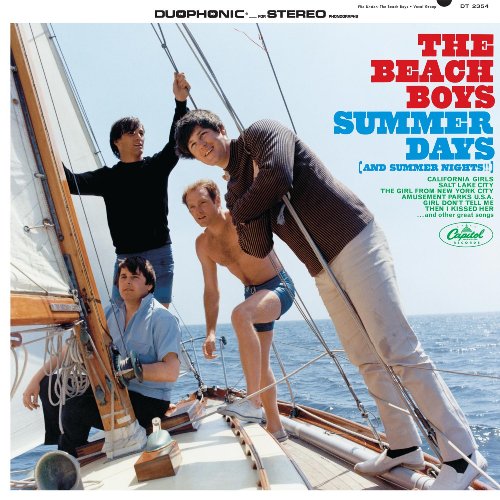
9. Summer Days (And Summer Nights!!) (1965)
Dave Roberts: Although Today! was an artistic success, the bigwigs at Capitol Records urged Brian to produce more light hearted songs. Summer Days (and Summer Nights!!) is the result, and while the music is every bit as adventurous as Today!, the lyrics re-focus on the fun fun fun of the past. Bolstered by two top ten singles (“Help Me Rhonda” & “California Girls”) the album reached #2 in the charts and is one of the Boys’ biggest selling albums.
Summer Days is the first album appearance for Bruce Johnston. Carl Wilson takes front and center with his first lead vocal on “Girl Don’t Tell Me”. Has there ever been a more iconic intro than on “California Girls”? Pure Americana.
Jon Springer: One of things [listening to The Beach Boys’ discography in order] has done so far, is demonstrate how refreshing a 25-minute album can be. Considering their direction on Today!, the Boys go a little retro on Summer Days (and Summer Nights!!) – note the two exclamation points!! – singing about amusement parks, good clean Mormon fun, and a couple covers including their own re-recording of “Rhonda.”
It’s hard to tell whether the sincere “Salt Lake City” and “Amusement Parks USA” are actually jokes or not, but the jokey-sounding “I’m Bugged at My Old Man” probably isn’t. Brian had recently fired Murray, and his folks subsequently split up; this removed a source of trouble from the band, but not from their lives of course.
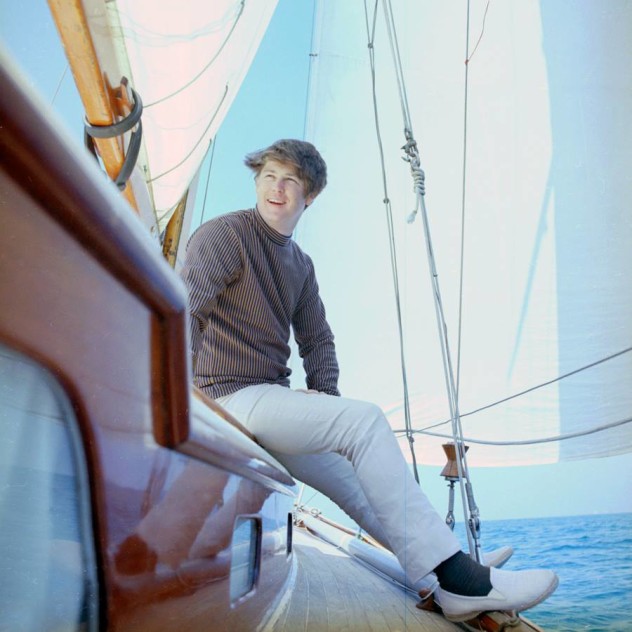
Uncle Wayne: OK, I admit: I have never given the Beach Boys the credit they (Brian Wilson) deserve. Of course, I know and love the diptych of Pet Sounds and Smile, and most of the early hits are certainly memorable, but scattered throughout these early, rushed, record-company-looking-over your-shoulder albums, there is some seriously good shit!
I was not a fan of Brian’s voice back in the day, but now, listening more closely, I am digging the heartfelt sincerity and vulnerability he could bring to a song. And some of the backing tracks are absolutely killer – I knew about the Wrecking Crew but didn’t realize how involved they were with the Beach Boys.
It’s unfortunate that these albums got diluted with so much filler – comedians these boys certainly weren’t. The Beatles fan in me again points out how no one else was putting out as many good songs on as many albums in as short a time as the Fabs, but that shouldn’t take away from the appreciation of the brilliant stuff that is scattered throughout these albums.
Dan Gorman: What could have been a step back in the wrong direction, after the forward-thinking Today!, Summer Days (And Summer Nights!!) is quite fun at times – and a pinch more consistent than their early LPs.
It certainly hangs together as an album texturally, for the most part, and features some variety (the acoustic strum-along of “Girl Don’t Tell Me” is a nice departure, here).
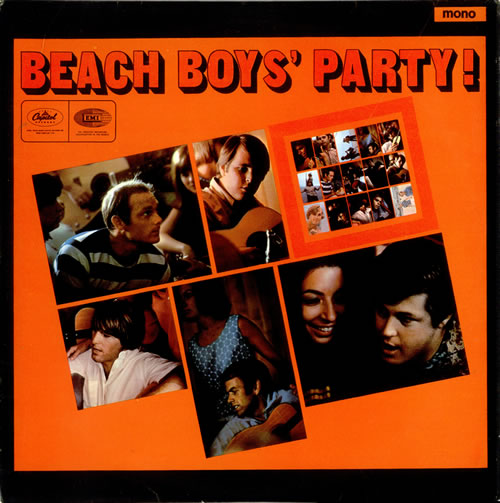
10. Beach Boys Party! (1965)
Dave Roberts: At the end of 1965, Brian began preliminary work on Pet Sounds. Knowing that Capitol would be clamoring for holiday season product, he slapped together this unplugged covers album – it was a big success, as was the “Barbara Ann” single.
And here lies the paradox: A large number of fans weren’t interested in the Beach Boys artistic development as much as remaining comfortable with familiar sounds – this fact would haunt the Boys for years to come.
As a side trip: don’t miss the original single, “The Little Girl I Once Knew” released in conjunction with the Party! album.
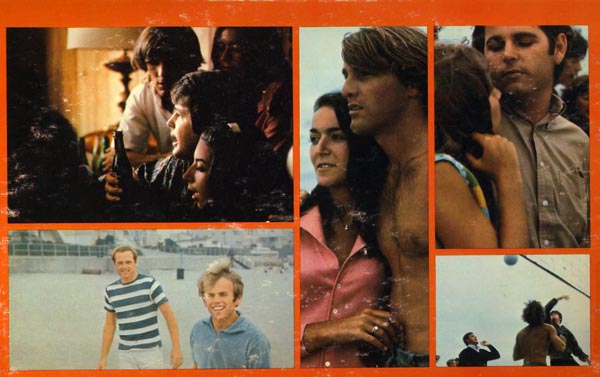
Jon Springer: Despite desperately overplaying their root-beer chugging, clean-cut, good-time image (which was a gigantic lie by this point), it’s not all that bad in the sense that it stands as a kind of primordial ‘unplugged’ record and also illustrates the richness that Brian’s arrangements brought to their non-party! recordings. Third straight Beach Boys album with an exclamation point in the title!
Uncle Wayne: Despite the hokeyness and hoaxiness of the Party! album, I kinda like it – especially Dennis‘s version of “Hide Your Love Away”. Took balls to cover 3 (!) Beatles songs.
Dan Gorman: While fake-live concept albums such as this (or Peggy Lee‘s Beauty and the Beat) fascinate me, I couldn’t see this one ever entering my rotation as a whole – though there are some highlights here, already noted out above is Dennis’ “You’ve Got To Hide Your Love Away”, complete with party-goers chanting in on the HEY’s.
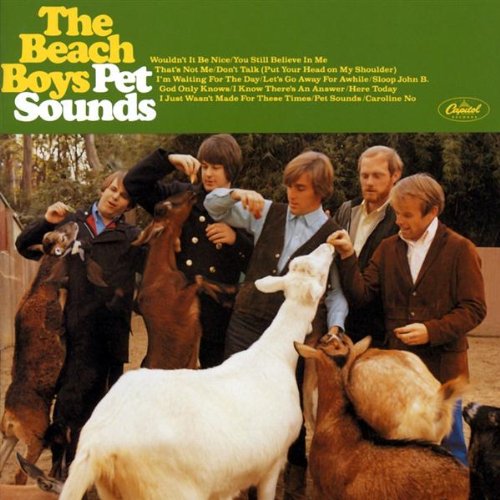
11. Pet Sounds (1966)
Dave Roberts: So much has been said about this album. So many superlatives, all valid.
I saw Pet Sounds on the wall of a record shop in the summer of ’66; the cover looked strange. Checked the titles and didn’t recognize anything so I put it back. The next month, I returned for the new Beatles album, Revolver. Again I held Pet Sounds in my hands, weighed the decision to buy… and left the store with only Revolver – which I devoured (my favorite Beatles album).
When Brian released “Good Vibrations” in October ’66, I bought the single and ate it up. I put that funny looking Pet Sounds album on my Christmas wishlist and, since Christmas day 1966, I’ve reveled in music incomparable.
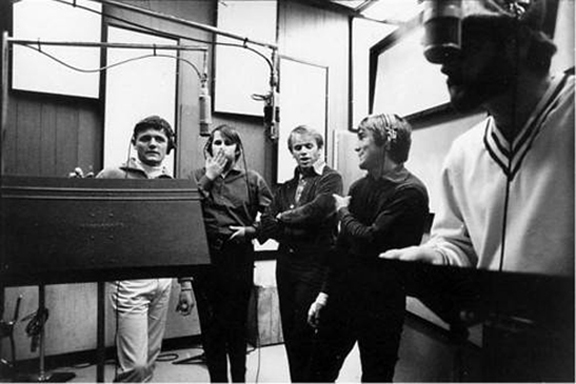
Uncle Wayne: So, four years and 9 compromised, uneven albums in, Mr. Wilson releases this near perfect album… it’s enough to make a grown Beatle cry.
Dan Gorman: Obviously, Pet Sounds was huge for me when I hit High School. I remember picking it up when I really started to dig into some major “must-hear” albums that I had yet to get around to. That summer – like many albums I would obsess over – I’d have it on repeat and cranked up high on my Dad’s old receiver and speakers.
I fancied myself tortured emotionally and romantically at the time, so the mix of beautiful harmonies and melodies (“You Still Believe In Me”) with such subject matter (“God Only Knows”, “I Just Wasn’t Made For These Times”) just landed at the perfect moment.
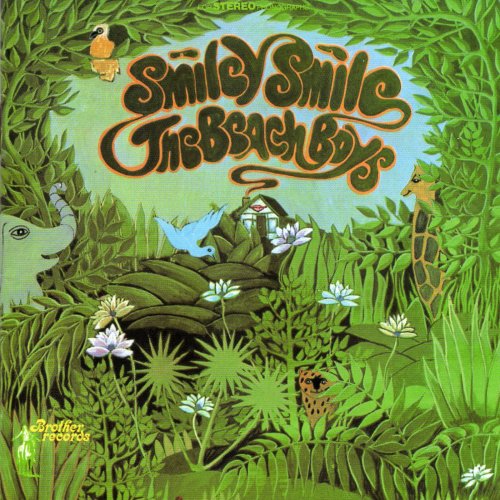
12. Smiley Smile (1967)
Dave Roberts: Coming off their #1 hit, “Good Vibrations”, Brian embarked on the highly anticipated next album, Smile. Those sessions were instantly beset with problems. The bands resistance to the lyrics by Van Dyke Parks led to Parks’ quick exit. Brian’s fragile mental state – overwhelmed by drugs, paranoia and self-doubt – caused delay after delay and finally, the project’s abandonment.
In June 1967, without an album to tour behind, the Beach Boys unwisely cancelled a headlining spot at the seminal Monterey Pop Festival. In eight short months, the band went from acclaimed to nearly being irrelevant, and as the music industry moved on from pop to rock, Brian retreated to his room where he more or less remained for a decade.
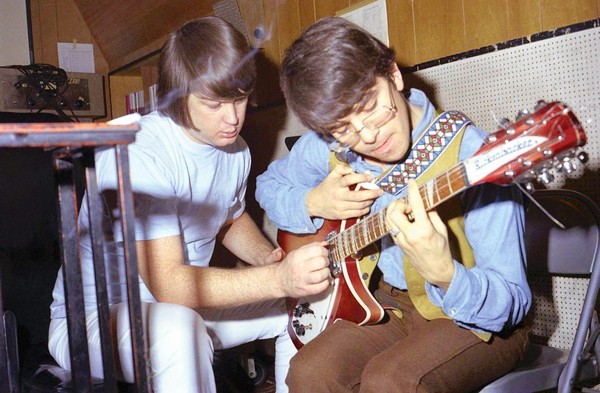
Smiley Smile was recorded at Brian’s unfinished home studio utilizing the singles “Good Vibrations” and “Heroes & Villains” along with reworked pieces from the Smile Sessions. When finally released in September ’67, the lo-fi album met with lukewarm response from fans and indifference from the record buying public.
I like the album more now than I did then – it definitely has a quirky sense of charm.
Uncle Wayne: Smiley Smile, so here’s where I do my drugs mantra/rant: sometimes drugs are good, sometimes drugs are bad – but drugs (of the “recreational” variety) and mental illness are pretty much always just a straight up disaster.
Brian Wilson tries to top the brilliant, unified statement that was Pet Sounds, but he has neither the mental clarity, the self-confidence, nor the support to follow through. From here on in, the Boys will release a series of albums which are maybe a little more consistent, and yep, they’re usually pretty good. They stand right up there with the likes of Three Dog Night and The Kinks of that time, but the moments of astonishing originality will be few and far between, and mostly not fully developed.
It’s a little heartbreaking to think what they might have been capable of if Brian had held it together, or if there was just one other person in the band on almost the same level to challenge and keep him focused.
Jon Springer: While it’s not especially fair to judge Smiley Smile against an allegedly superior work with the advantage of not actually existing, I still think it’s a bit of a mess even though it includes the stunning “Good Vibrations” and one of the more accessible Smile pieces, “Heroes & Villains”. Brian’s revamped Smile includes bits of what existed here, but done better – albeit with the benefit of 40 extra years to get it right.
Dan Gorman: Smiley Smile definitely feels patchwork – the extended instrumental moments don’t always work, but when they do (the oddball “Little Pad” segueing into “Good Vibrations”) they work like gangbusters. Definitely an intriguingly quirky album, and the murky-ish production actually lends it an otherworldly kind of floating feeling – dig on the distance allowed to sit between all the layers in some of the weirder vocal-based tracks.
The second half, post-Vibrations, especially feels a bit light-weight, which probably didn’t help the album much at the time of release.
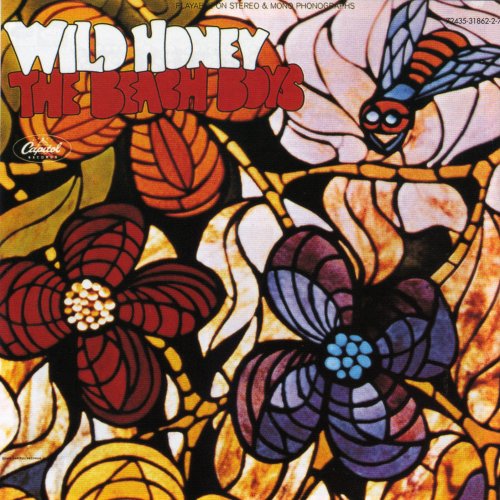
13. Wild Honey (1967)
Dave Roberts: In a musical landscape filled with the likes of The Beatles, The Rolling Stones, Jimi Hendrix, Cream, The Who, The Kinks, Small Faces and the emerging sound of FM Underground Radio, the Wild Honey album didn’t hit my radar. I had checked-out of Casa de Beach Boys and wouldn’t return until 1970’s sublime Sunflower album. When looping back to Wild Honey, Friends and 20/20, I discovered a solid trio of albums bursting with musical inventiveness.
Wild Honey was recorded at Brian’s home, and – except for some horn overdubs – all the instruments are played by the band. Producing credit is given to the entire group; Brain’s still involved here, but to a lesser degree.
Wild Honey is a more confident album than Smiley Smile. The song “Darlin'”, with Carl Wilson on lead vocals, was in the Beach Boys’ live set for decades and always delivered.
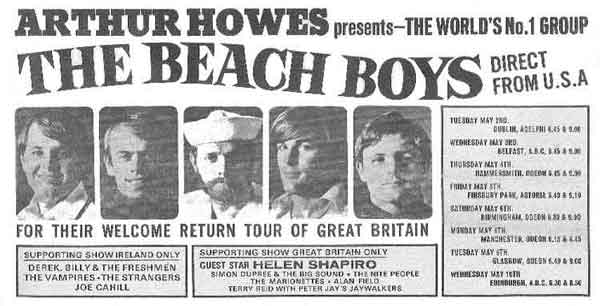
Jon Springer: The R&B;/soul influenced Wild Honey is a big improvement on Smiley Smile. It’s soulful and easygoing, and it doesn’t bash you over the head with its Beachboyishness, which is no doubt in part due to less Brian as he and they (d)evolved: less painstaking, resulting in a record that’s a little more organic if atypically spare sounding.
Dan Gorman: Wild Honey begins what is probably my favourite period of Beach Boys history – the post-Smile-session albums. With Smiley Smile out and over with, an album like Wild Honey almost sounds refreshing. Maybe it benefits by being out from the shadow of the aforementioned album, but Wild Honey is sweet, funny, short and to-the-point while still feeling kind of funky with its R&B influences.
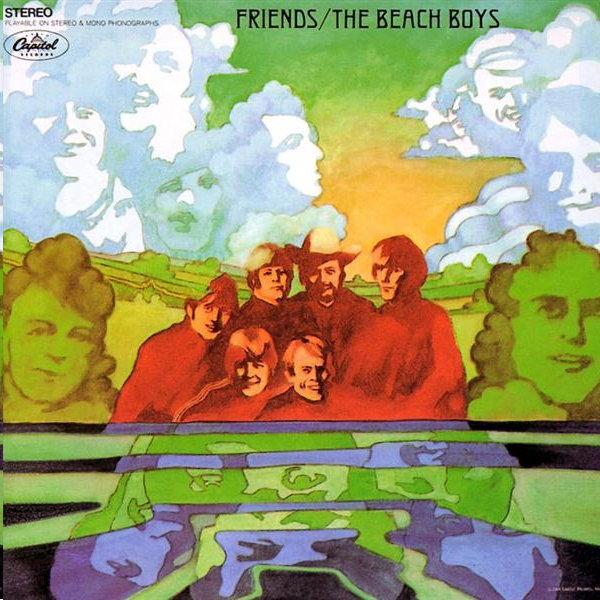
14. Friends (1968)
Dave Roberts: Released in the turbulence of America-1968, this meditative, blissful offering is one of my favorite Beach Boys’ albums; twelve songs in twenty-five minutes and not a moment wasted.
A few of the Wrecking Crew are back to bolster the sound. Dennis offers two of his early songwriting efforts with “Be Still” and “Little Bird” Brian gives you directions to his home (and mental state?) with “Busy Doin’ Nothin’”.
Jon Springer: Even less hit-laden than its predecessor, Friends strikes a little boppier posture, and is loaded with happy songs about depending on family and friends, and giving and receiving help. I don’t fault them for trying and I believe they are sincere, but much of the mysticism here comes off as clumsy — “everybody’s gone Meditatin’, Meditatin’ USA!!”
The public didn’t buy it either: a subsequent tour with the Maharishi Yogi as an opening act was an embarrassing failure. Overall this record starts strongly but doesn’t keep it up and lacks a big, walloping hit. Not bad, but inconsequential.
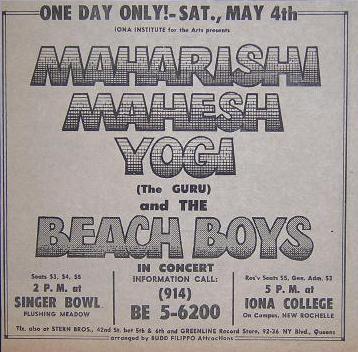
Dan Gorman: I’m with Dave on this one – while it seems featherweight at the length it clocks in at, Friends is an LP that I keep returning to again and again, lately. There’s just something about the chill flow that I’m digging a lot. Definitely sneaks up on you, and can be quite addictive.
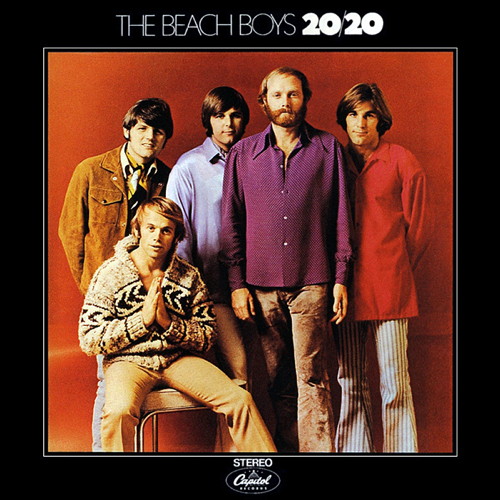
15. 20/20 (1969)
Dave Roberts: In late ’68 and throughout 1969, the Beach Boys fortunes were at their lowest ebb. Practically a non-entity on the U.S. touring circuit, the Boys could only pull a few hundred to a show. Yet, in Europe their songs never left the charts and audiences embraced the band in large numbers. Carl and Dennis took the reigns at this point, both in the studio, and on tour. They owed Capitol one more album, so a collection of singles (three Dennis originals, Brian’s demos, Smile leftovers, a Leadbelly cover and Bruce Johnston‘s first composition for the band) is the result.
“Time To Get Alone” is a true lost gem. The Beach Boys Lifer Brigade will want to check-out Live In London ’69: a fine representation of what the band sounded like on tour in 1969.
Jon Springer: The Boys tackle a wide variety of their various styles on 20/20, leading off with a sharp revisiting of their surfing anthems in “Do It Again”, but also including songs illustrating the ascension of the younger brothers (Carl’s singing and producing especially on “I Can Hear Music” and Dennis’ songs, the best of which is “Be With Me.”)
They also make an attempt for a second “Sloop John B,” though not as successfully with “Cotton Fields.” Finally they end up with two of the best pieces of Smile, the oddly gorgeous and lush “Cabinessence” and “Our Prayer.” Along the way you get a song with a big giant guitar solo (“Bluebirds Over the Mountain”) and an instrumental (“Nearest Faraway Place”) that’s closer to easy-listening than Pet Sounds stuff. In all, varied parts that don’t fit together seamlessly but isn’t that the Beach Boys all over.
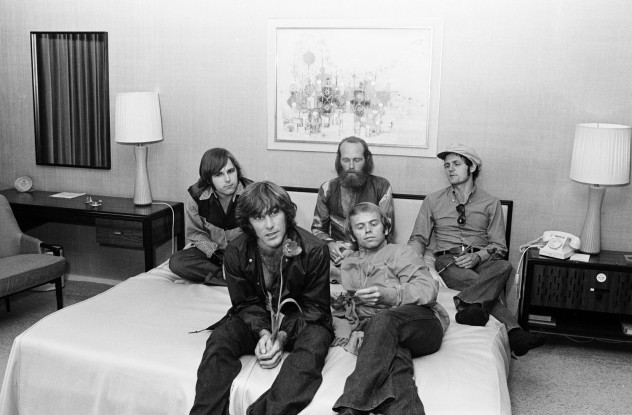
R G: 20/20 is so varied, I wouldn’t have realized it was the Beach Boys had I not known what I was listening to. It’s fascinating to play their albums in chronological order and “hear” how they changed over the years. Once again, I stand amazed at how little I knew of their music – even though I could sing along to every radio hit.
Dan Gorman: After really digging the vibe they dished up on Friends, you’d think I wouldn’t go for a record as all-over-the-map as 20/20, but this just continues their streak of overlooked albums – it’s odd that for a band riddled with interpersonal with issues around the creation of Smile would bounce back with a run of records this interesting, instead of coasting through weakly.
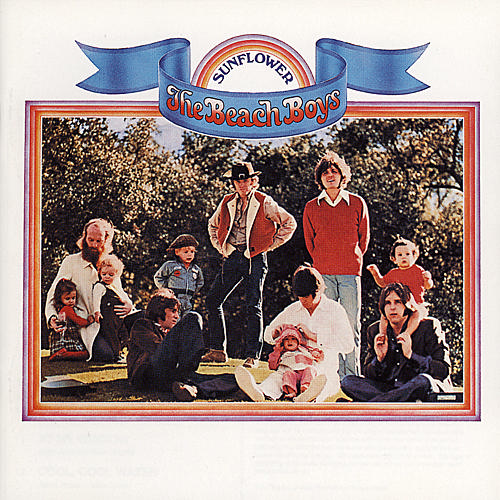
16. Sunflower (1970)
Dave Roberts: The revival starts here. The label-less Beach Boys found a patron saint in Reprise Records chief Mo Ostin. Not only did he sign the Boys to Reprise, he revived their Brother Records imprint. Sunflower was the first of it’s fruits and, although a commercial dud, was heralded by rock critics. Tour buzz for the band increased and led to triumphant performances at Carnegie Hall and the Fillmore East.
Jon Springer: Unlike some of its immediate predecessors, this is a confident, collaborative and cohesive record marrying the sunny themes of Friends with the attention to production they had last on Pet Sounts. And, with all members contributing good stuff as writers and singers, it’s hard to see what went wrong other than popular tastes shifting toward harder-sounding stuff than the Beach Boys could offer here, despite their rip-roaringest rocker yet (“It’s About Time.”).
I like the first six songs on this record especially – all of them sound great – before they shift into ballad mode and get a little sugary, but even then (the twee “At My Window”) things are pretty good. The disc finishes with another re-working of Smile material, “Cool, Cool Water.”
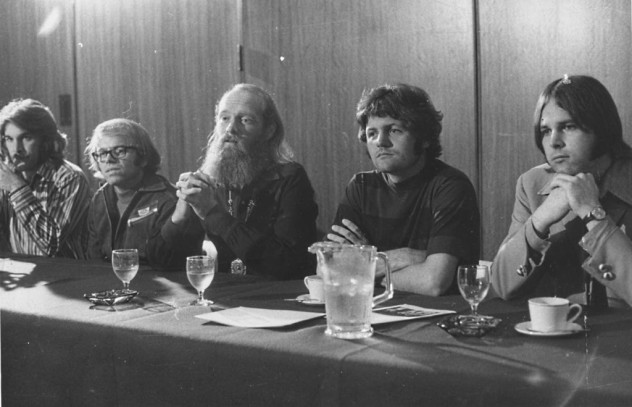
Dan Gorman: When I discovered Sunflower, I didn’t yet know that The Beach Boys had any other albums that could approach something as consistent as Pet Sounds – obviously since then I have come to love many of their records, but this was my first taste of their album work outside of knowing Sounds and their surfin’ singles.
It kind of blew me away – the proto-chillwave vibes of “All I Wanna Do” and the amazing melodies on “This Whole World” had me hooked. I really like some of the albums leading up to Sunflower, but this is the band truly hitting another record out of the park.
Dave Roberts: I was working at a record store when Sunflower arrived. Dug the cover so I put it on. Every song hit the sweet spot. Dennis excelled with four compositions: “Slip On Through”, “Got To Know The Woman”, “It’s About Time” (with Carl) and the bona-fide classic, “Forever”. Carl produced and sang brilliantly throughout. Even Brian ventured out of his room long enough to lay down a little slice of heaven, “This Whole World”.
The next few albums would see the Beach Boys re-capture a wide and appreciative audience. But from an artistic standpoint, it doesn’t get much better than this.
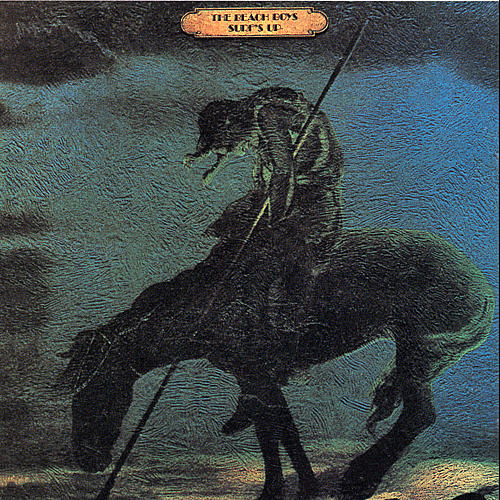
17. Surf’s Up (1971)
Dave Roberts: While not as cohesive as Sunflower, Surf’s Up delivers big rewards. Bruce Johnston turns in his best song with “Disney Girls (1957)”. Carl’s first two solo compositions (“Long Promised Road” and “Feel Flows”) are outstanding.
The last three songs are Brian’s by way of Carl’s production. It took Brian a year to write and arrange the melancholic beauty, “’Til I Die”; worth it.
Jon Springer: Surf’s Up begins provocatively enough with the admonition “Don’t Go Near the Water” but ultimately turns out to be another Beach Boys song where the message is well-intentioned, but delivered ham-fistedly (like “T.M.” from Friends). Brian contributes the typically goofy “Take a Load off Your Feet” as well as the final three songs, driving home a considerably more somber feel on this record than on Sunflower.
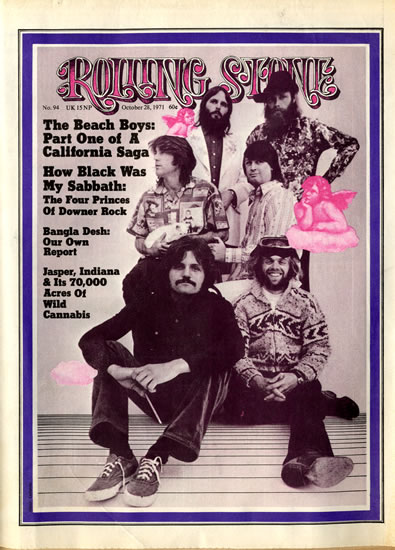
Dan Gorman: The thing that struck me most about Surf’s Up when I discovered it – just after becoming obsessed with Sunflower – was the juxtaposition of the title and album cover. You’d expect a throwback to their surfin’ days, but the stark and bleak cover art just stood out to me. The first time I heard “Student Demonstration Time”, I wondered why Pac-Man was demonstrating; but, there’s a lot of gold on here, and it certainly fits well in this period of artistic rejuvenation for the band.
Dave Roberts: The title track, “Surf’s Up” is the last and best of the Smile session re-records. For the first movement, Carl overdubs his vocals to the original 1966 backing track. The second movement is Brian’s original piano demo augmented by vocal and MOOG bass overdubs. The final movement combines Smile‘s “Child Is Father Of The Man” snippet with a new lyric and choral fade-out featuring all of the boys.
Let the waves wash your blues away.
Jon Springer: If you’re up for a side excursion as you get to Carl & The Passions and Holland records, I can recommend Blondie Chaplin‘s 1977 solo album. He might have been miscast as a Beach Boy, but he is a fine guitarist and singer who went on to tour with the Stones for years (may still be, I dunno). His album is nothing groundbreaking, but a solid mid-70s rock record.
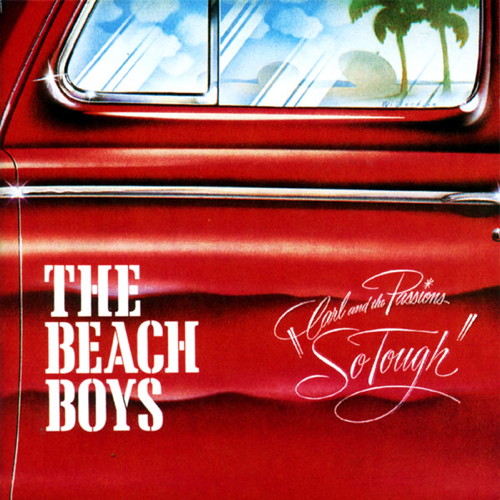
18. Carl & The Passions – “So Tough” (1972)
Dave Roberts: By 1972, Carl was the undisputed leader of the Beach Boys both in the studio and on the road. Dennis was sidelined with a severely injured hand and Brian confined himself to the bedroom and kitchen. Mike & Al were more interested in playing nostalgically safe, and Bruce quit the band at the start of the album’s sessions.
So, it was up to Carl to keep it alive. Always a fan of Soul and R&B, he hired two members of the band The Flame to add muscle and direction to the B.B. sound.
Jon Springer: All that going against it, and still there’s stuff that ought to be listened to on this record. The new members (singer/guitarist Blondie Chaplin and drummer Ricky Fataar) arrive confidently behind “Here She Comes” even though I’d sooner guess I was hearing the Atlanta Rhythm Section than the Beach Boys. The two songs that best fits the Beach Boys feel are “Marcella” and “All This Is That.” We get a few schmaltzy ballads in the second half that steer the thing off the rootsy track, and it again lacks that knockout punch single that good Beach Boys albums ought to have.
SO TOUGH… to figure out.
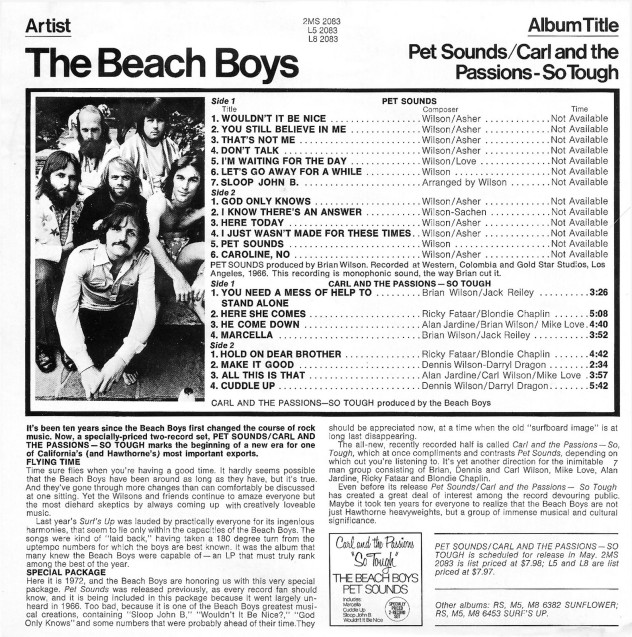
Dave Roberts: In a perfect world, Brian’s composition “Marcella” would have been a #1 hit song. Dennis pulls out all the emotional stops and foreshadows his solo album (Pacific Ocean Blue) with “Cuddle Up”. This was the last Beach Boys album recorded in Brian’s home.
CY*: How can any soul not love “Cuddle Up”?
Dan Gorman: I’m pretty into the driving-sound they put forth on some of these cuts – “Here She Comes” especially. Whenever I see an album like this – with a title like that, almost looking like a side-project rather than a full-band release – I start worrying. This one has some choice cuts for sure, though it seems a bit at odds; “He Come Down” struggles between the classic Beach Boys sound and toying with gospel vibes, and seems to reveal the inherent problems that exist within this seemingly transitional release.
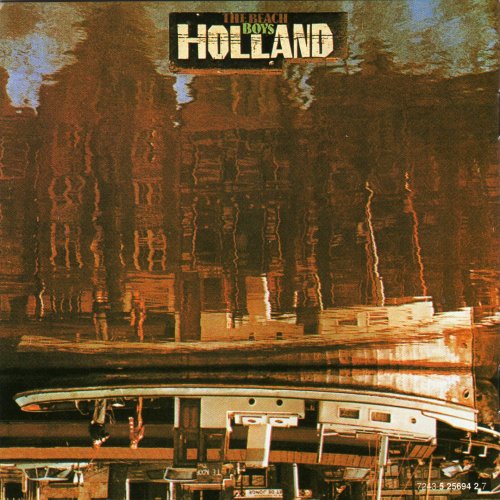
19. Holland (1973)
Dave Roberts: What a dumb idea: looking for inspiration and thinking a change of scenery might jump-start Brian’s creative juices, the boys packed up an entire studio and moved to the Netherlands in the summer of 1972. It was only then that someone realized all the American equipment would have to be re-calibrated to work on the European electrical grid.
After three aborted plane flights, Brian arrived in the Netherlands. He fiddled around with the piece called “Mount Vernon And Fairway” and two weeks later, returned to L.A.
Somehow, Carl pushed the sessions through, only to have Reprise reject the album as being noncommercial. A single was needed to strengthen the album so they turned to Brian who always had some unpolished gem lying around. The gem turned out to be “Sail On Sailor”. With assistance from Van Dyke Parks, Brian and Carl completed the track.
And it’s a damn fine album – an excellent production. “Sail On Sailor”, “Steamboat”, “Trader”, all shine.
Jon Springer: So maybe the Beach Boys are a “progressive rock” band after all. Holland to me sounds like is an improvement on So Tough, with a laid-back organic groove and surprising contributions throughout.
The three-part “California Saga” complete with a waltz, spoken-word passages and flutes is the kind of thing Mike & Al might have slaughtered 9 times out of 10 but they pull it off here convincingly, striking the same balance of joy and melancholy present in some of Beach Boys best stuff through the years. That, and Carl’s “The Trader” are the highlights here.
Brian’s “Sail On Sailor” was bolted onto the finished product when the label needed a single but its message of perseverance resonates as these guys make another good record against long odds and without much reward.
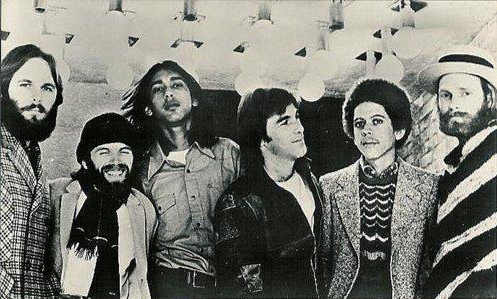
Well, taking the studio overseas and expecting it to work probably was a dumb idea, and apparently was also a colossal waste of money, but in the sense Holland gave Mike & Al the homesickness to come up with the yearning “California Saga” and (I’m just guessing here) being amid the Dutch inspired Carl’s “The Trader” – maybe the trip wasn’t a total waste.
What’s really impressing me by this point is how well they continually trudge ahead amid all the crap in their path.
Dan Gorman: I feel like I should hate the “California Saga” – including the spoken word moments – but I kind of love it. Despite everything that was going on during the creation of Holland, I feel like they were really on to something with some of the tracks here – especially with some of the synth/organ work, which I feel like foreshadows what we’ll hear on Loves You.
The whole thing has a very soft-rock-by-way-of-lite-prog feel, but it works for me. And I have to say, “Only With You” would rank pretty high up there on a personal list of Beach Boys love-songs.
Uncle Wayne: Holland has the memorable “Sail On Sailor”, the mostly good “California Saga” (no poetry please) and “Trader”. It’s interesting how seamlessly Chaplin and Fataar fit into this edition of the band.
Bits and pieces of the other albums show glimpses of what might/could/should have been in a perfect world but…
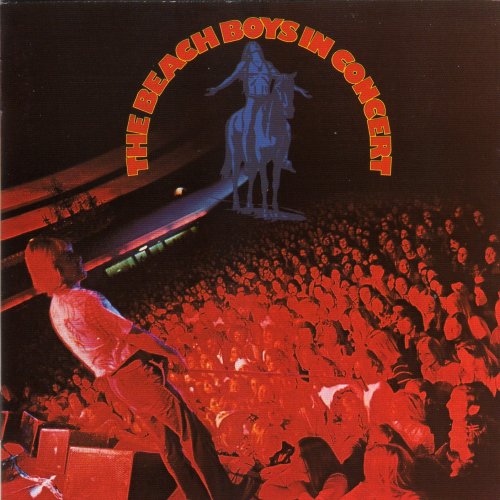
20. The Beach Boys In Concert (1973)
Dave Roberts: In 1970, The Beach Boys were lucky to have a few hundred fans turn up for a performance. By 1973, they were selling out twenty thousand seat auditoriums. They succeeded by constantly touring and delivering one of the best damn shows around. Beach Boys performances were a true testament of impeccable sound and raw emotion. I was fortunate to have experienced this era of the band on three separate occasions; Carl singing “Surf’s Up” and Dennis singing “Forever” are but two of the many magical moments I hold dear.
One of the highlights of a Beach Boys set was always “Wouldn’t It Be Nice”; listen to the way the band slows toward the percussion crescendo into the final refrain of “You know it seems the more we talk about it. It only makes it worse to live without it. But let’s talk about it. Wouldn’t it be nice.” A thing of beauty.
Dan Gorman: Carli Muñoz ripping out a sick Hammond B3 organ jam about three minutes into the live cut of “Leaving This Town” blew my mind when I first heard it – how did I not know that The Beach Boys were such a tight live group? I guess all the turmoil behind the scenes made me assume that they must have been a fright to see live around this time.
This fresh slab of wax proves otherwise again and again though, with tight-as-hell grooves and great takes on their older material – what a touring band they gathered up here! This is one that will be in my rotation for a while, it’s just fantastic.
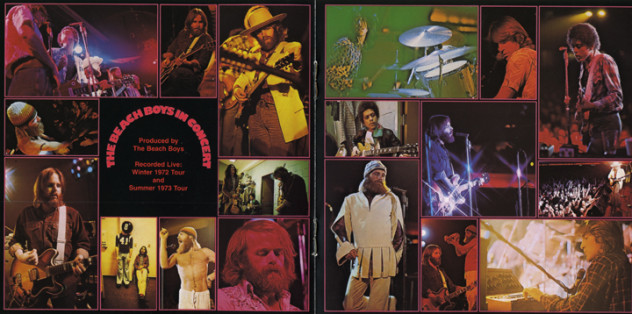
Jon Springer: Being a 9-year-old who knew Endless Summer and nothing else, I was among those expecting more of the same after buying a used copy of In Concert at a neighborhood garage sale for 50 cents, but I found it way too dense and lacking the clean spark of their recorded 60s hits and didn’t give it much of a chance. Sounds better to me today, certainly Blondie Chaplin was earning his keep at this point in their history.
Fast forward to 1998, and I’m sharing an apartment in Hell’s Kitchen with a former fashion model and come home one night to find my roomie has several guests over who were in town as part of the Stones tour including Blondie Chaplin, whose Beach Boys stint I brought up upon introduction. I’m not sure here, but I think maybe the roomie and Blondie may have been involved at some point in the past. I wish I had more to the story than that, but mostly recall a nice group of folks sitting around in the kitchen smoking and having drinks.
The building we lived in doesn’t even exist anymore.
*A Moment of Transition*
Dave Roberts: In 1974, Capitol Records plundered the old catalog to reissue yet another greatest hits album called Endless Summer. The album sold in record numbers, shot to number #1 on Billboard and remained in the charts for 3 years. It was followed by another hits compilation call Spirit Of America in 1975 which reached the top ten and went gold.
This mixed blessing served to fill the Beach Boys coffers while tilting them towards being solely a nostalgia act. It was near impossible to introduce new material to a festival crowd clamoring for the likes of “Barbara Ann”.
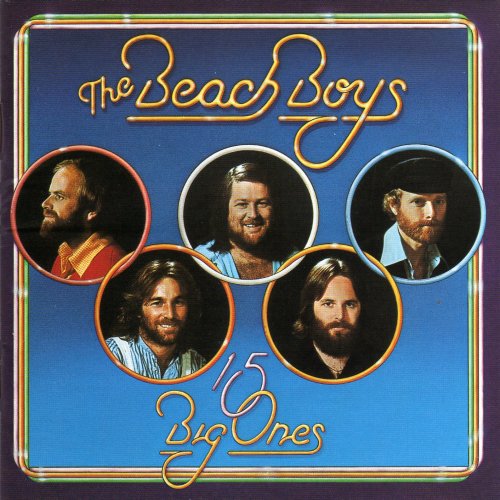
21. 15 Big Ones (1976)
Dave Roberts: By 1975, Brian Wilson had secluded himself in the chauffeur’s quarters of his Bel-Air estate. Living on a diet of cocaine, booze, smokes and cheeseburgers. He rarely engaged with his wife (Marilyn), his children or his brothers; he was gone, down the rabbit hole.
Marilyn and the Wilson family sought the help of a therapist. Enter: Eugene Landy, with his radical 24 hours a day monitor maintenance program. There’s neither the space nor the inclination to delve into the dubious and devious practices of Dr. Landy. In the short term, Landy got Brian back on his feet and into the studio – even propped him up for a few concert appearances during 1976’s ill-fated and fraudulent “Brian Is Back” campaign.
15 Big Ones meant 15 years in the music business. Released in the bicentennial summer, the album is comprised of half originals and half covers. Though the album racked-up big sales numbers, the Boys had become just another rock commodity for me.
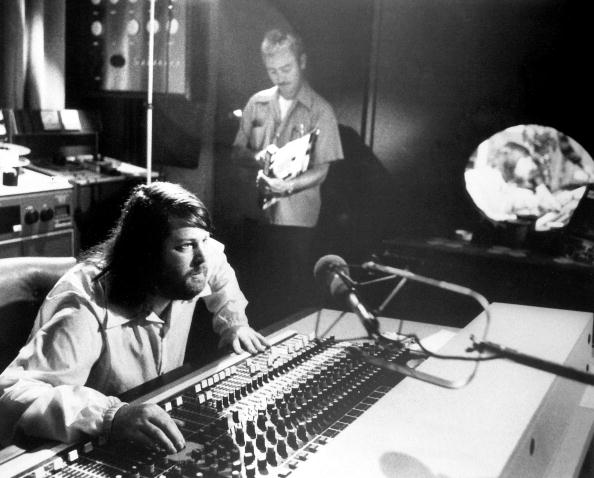
Jon Springer: The downside of the big-selling Endless Summer / Spirit of America comps was that they may have fooled the remaining coherent members of the Beach Boys that retro was the way to go, if and when they stopped counting their money, taking drugs and eating. Brian emerged from more than 3 years in hiding, obese and with a ruined voice and – to the extent he had any determination – in a mood to record some ’50s covers. Dennis also went raspy-voiced as you can hear on “In the Still of the Night.” The new stuff is best exemplified by the title “It’s OK.” The covers to me sound sterile and in need of a little love.
Dan Gorman: They go from the promising evolution of Holland, to this? C’mon. “Had To Phone Ya” works, likely since it was written in the ’60s, but 15 Big Ones is overly maudlin (those flutes in “Everyone’s In Love With You”, eesh) and overall just feels too calculated.
Dave Roberts: Would the artistry ever return? Yep, and from a pleasantly, unlikely source…
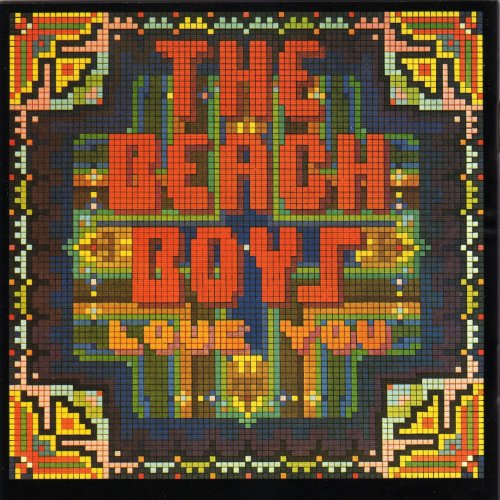
22. Love You (1977)
Dave Roberts: The working title for this one was Brian Loves You. Finding inspiration in the Beach Boys new Brother Studios, Brian demoed 16 original tracks over a 5 week period in October-November of 1976. Unfortunately, a disastrous solo performance on Saturday Night Live (at the behest of “Doctor” Landy), and the discovery that he was double-billing Brian for his services, led to Landy’s firing – and Brian’s withdrawal into drug relapse.
In early 1977, Carl dusted off the demos, added guitars, vocals and other overdubs. The result is an eccentric little album filled with autobiographical references (that’s Brian and Marilyn on “Let’s Put Our Hearts Together”) and Brianesque melodies. Despite the silly songs “Honking Down The Highway” and “Solar System”, this album ranks pretty high in the canon.
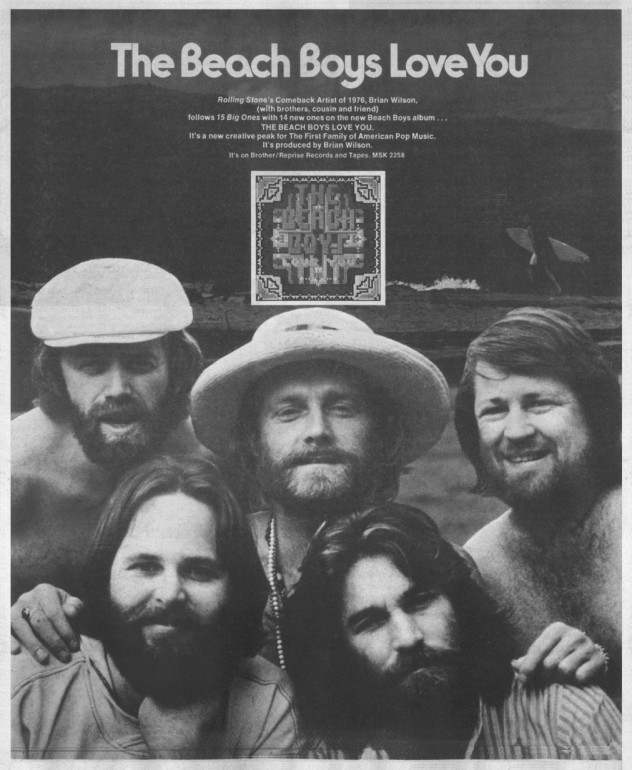
Jon Springer: Channeling his ’50s jones on new material (as opposed to covers) serves Love You better than its predecessor. The disc consists almost entirely of Brian’s songs so we get some goofy, childlike stuff amid heavy synth sound but in all this is an enjoyable if not terribly substantial record.
Dan Gorman: This album – much like some of the post-Smile records – is a fascinating curve-ball piece of the Beach Boys puzzle to me. The dirty stripped-down synth sound going on here is totally ahead of its time, and the unfiltered, child-esque Brian Wilson-isms are kind of off-putting on first listen – but the more I dig into it, the more it really fits together.
Any album where bizarre odes to the Solar System, rollerskating children and Johnny Carson sit neatly beside introspective/autobiographic numbers (“The Night Was So Young”) is one you should probably hear.
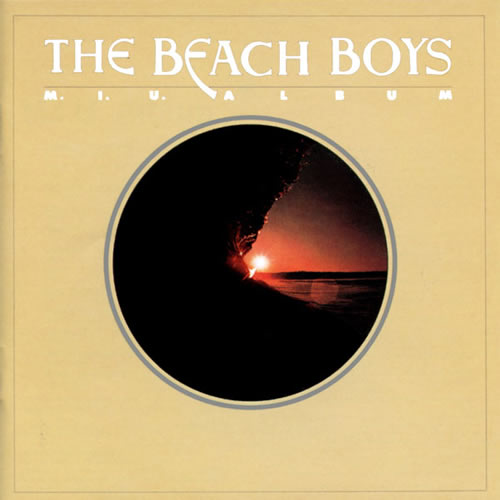
24. M.I.U. Album (1978)
Dave Roberts: Even a Beach Boys fanatic (such as myself) will have to admit that M.I.U. Album is a stinker.
It was spearheaded by Mike Love (never a good sign) and produced by Al Jardine after Brian proved incapable. Most of the melodies are Brian’s, but they’re mostly generic toss-offs. Carl and Dennis refused to participate on the sessions and only contributed a few vocal parts. Actually the best song here wasn’t written by any of the Beach Boys but by Al’s friends Ron Altbach and Ed Tulega: the harmonically rich “Winds Of Change.”
Jon Springer: M.I.U. Album continues the oldies-act direction they’d been going in. At times it can be interesting – Brian’s falsetto on “She’s Got Rhythm”, a well-sung cover of “Peggy Sue”, goofy stuff like “Tomboy” and “Match Point Of Our Love” – but on the whole unremarkable and bland.
Dan Gorman: After a series of rejected albums, what we end up with was M.I.U. Album – including songs originally created for a Christmas release, but re-dubbed with re-written, non-Holiday lyrics. Another retro-throwback, by this point I have no interest in hearing the Boys sing about baseballs and skateboards – especially on a song as offensive as “Hey Little Tomboy” (where the Boys teach a tomboy how to ‘turn into a girl’). BARF!
At the very least, M.I.U. Album sounds more engaged than 15 Big Ones, but only marginally. It’s rendered in a too-similar sheen throughout, and is the definition of “forgettable”, to my ears. A few songs work, as stated above, but the run of “comeback” albums seems to be fading into the distance…
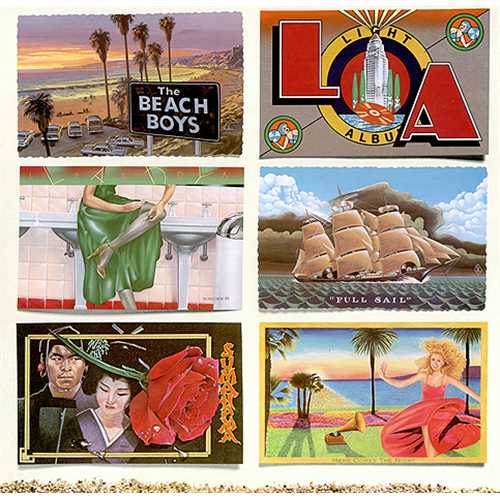
25. L.A. (Light Album) (1979)
Dave Roberts: This is more like it; 1979’s Light Album has all hands on board. Well, Brian’s still in the shadows, co-writing “Good Timin'” with Carl and vocalizing on only one other (“Angel Come Home”). I like Al’s take on Bach with “Lady Lynda”; even Mike is tolerable with “Sumahama”. Bruce Johnston returned to produce the album when Brian bailed.
A solid album but whatever you do, avoid the 10 minutes 51 seconds of water torture known as “Here Comes The Night”: a disco re-working of the Wild Honey track.
Two songs by Dennis: “Love Surrounds Me” and the sublime “Baby Blue” (on which Carl and Dennis share lead vocals). These are the final two tracks by Dennis released before his death.
Jon Springer: On Light Album the Beach Boys ditch the conscious retro of their previous few records and try to be contemporary, but thanks in part to Brian’s check-out they just don’t have the material. I can’t work up the indignation some fans have for having re-worked “Here Comes The Night” into an 11-minute disco song because it’s just not important enough. I’m going to give Al Jardine a nod here with the extra cheesy but well sung and well-intentioned “Lady Lynda.” I also like “Baby Blue” and think Mike’s Japanese song doesn’t suck that much.
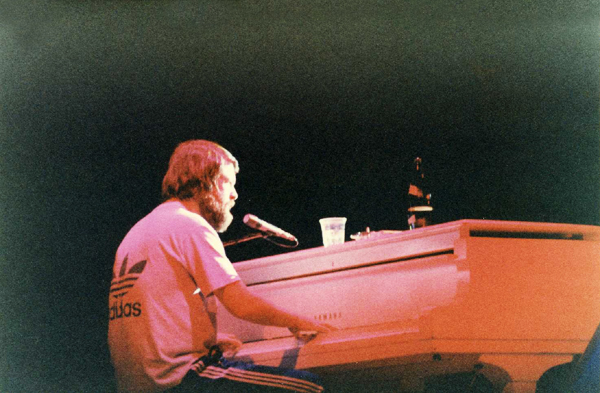
Dan Gorman: “Good Timin'” opens up the record, and has me scared that they’re sticking to this a-fond-look-back-on-our-old-sound kick. As it goes along though, I start wondering if maybe this one will be a return to form – but alas, this is just another (in a soon-to-be-very-long-running) attempt to meld their oldies-vibe with modern pop production (see: the pop-strings of “Ladie Lynda”, or the curiously awful disco version of “Here Comes The Night”).
Most of the songs with potential here seem ruined by their arrangements or production, in my opinion.
I had high hopes for Dennis’ contributions, but while “Baby Blue” is passable, “Love Surrounds Me’s” execution is disappointingly cheesey – what could have been a brooding downtempo and introspective track has awkward chimes and other additions.
No, thanks.
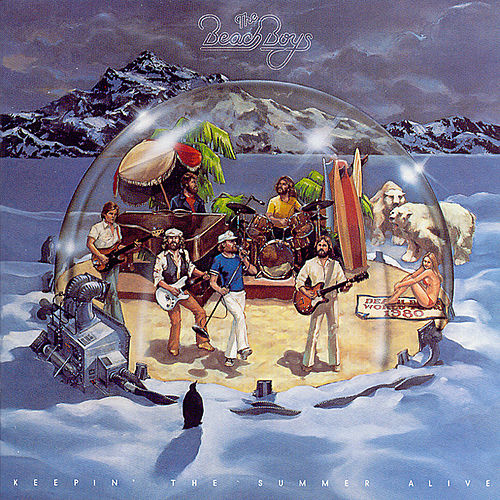
26. Keepin’ The Summer Alive (1980)
Dave Roberts: In yet another attempt to return to the wellspring, sessions were arranged to take place at Western Recorders: the site of the Beach Boys’ early triumphs. That came to an abrupt halt when Dennis walked out and Brian refused to record anything but rock ‘n’ roll oldies.
Jon Springer: Continues the troubling trend toward casting the Beach Boys as a kind of dorky Jimmy Buffet-style resort-band. Even while the harmonies still work at times, the bubble-gum and country songs sound inauthentic, and the album cover is awful. You can hear a little BTO boogie near the end of the title track, which was co-written with Randy Bachman.
Dan Gorman: I’m with Jon here – we have now fully left the underdog-look-at-’em-go era and entered something way more troubling. I long for the pleasantries of Holland, at this point. This stuff is just not for me – though unlike Jon, I (surprisingly) don’t hate the cover art, there’s something oddly fascinating about how dated it looks…
Dave Roberts: Bruce Johnston took over as producer and, with Mike, Al and Carl helping pump out this mediocre effort. Four new Brian and Mike songs were included – also, Bruce’s “Endless Harmony” and a couple of other songs from the late sixties/early seventies vault.
It would be 5 years before the Boys would release another album.
*Another Moment of Transition*
Dave Roberts: By 1982, Brian had hit rock-bottom. His condition was so bad that the Wilson Family reluctantly re-hired Eugene Landy. Therapy brought an overall improvement to Brian’s health. He lost 150lbs and took on a physical fitness regime. And while the over prescribing of psychotropic drugs may have accounted for some of Brian’s neurological disorders, there’s no question that Landy successfully treated Brian’s drug dependence.
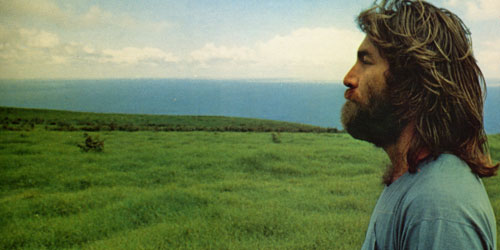
Dennis wasn’t as lucky. Lost in a fog of drug and alcohol addiction, Dennis spent the last few months of his life homeless; crashing on friends couches, shacking up in cheap hotels and wandering the streets of Santa Monica and Venice, as if an apparition.
On December 28, 1983, Dennis Wilson died of accidental drowning while diving between the boat slips at Marina del Ray. Drunken misadventure… just goofin’ around. He was 39 years old.
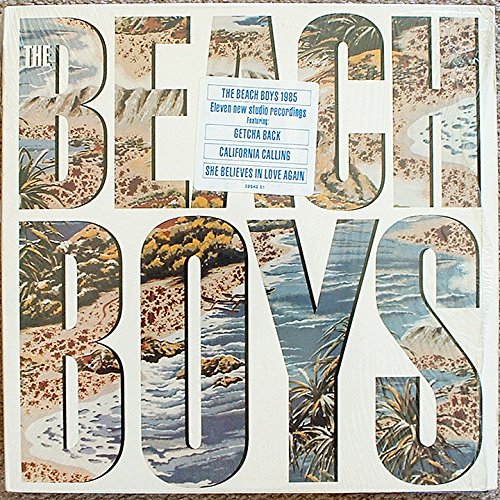
27. The Beach Boys (1985)
Dave Roberts: The Boys brought in Culture Club producer Steve Levine who gussied-up their sound with drum machines etc. which instantly dated the vibe of this 1985 release. Stevie Wonder offers a song (and a harmonica) on “I Do Love You” and Ringo plays drums on “California Callin'”. “Getcha Back” is a good one – and that’s about it.
Jon Springer: The drum beat beginning “Getcha Back” was supposed to have been a tribute to Dennis’ sloppy signature style but most of the beats on The Beach Boys are electronic and artificial as was the style of the time.
This includes some dreadful ballads that could be mistaken for Billy Ocean – or a soundtrack from a generic 80s film – a Mike Love song that sounds like a Beach Boys parody (“California Callin'”), covers of Culture Club and Stevie Wonder songs that sound more like their contributors than the Beach Boys, and Brian stuff filtered through Eugene Landy.
I’d only listen to the first and last songs.
Dan Gorman: The more they add modern flourishes to their classic sound, the more desperate it comes off – culminating with this attempt to “go 80s”. One look at the “wacky” music video for “Getcha Back,” and you’ll understand.
Still Cruisin’ (1989) and Summer In Paradise (1992)
Dan Gorman: The “Kokomo”/Stamos years. Brian Wilson didn’t contribute to the latter, which featured a song utilized in a Baywatch episode.
While there may be some content of interest here for some listeners, the less said, the better, methinks. These albums were unavailable on Rdio at the time of this project’s inception, so none of the contributors had discussed them.
I’ll go on record saying that I probably hate “Kokomo” a lot less than most people. I’d take that song over some of the more forgettable moments on the previous albums, in a heartbeat – at least the hook is a major one. Compare it to the track linked above for Still Cruisin’, why don’t ya?
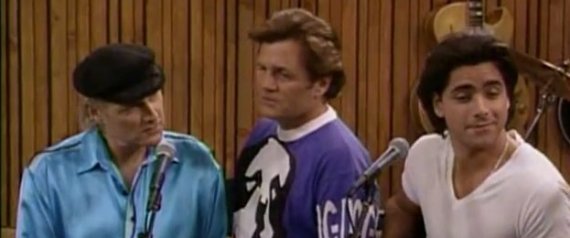
*Wrapping Up*
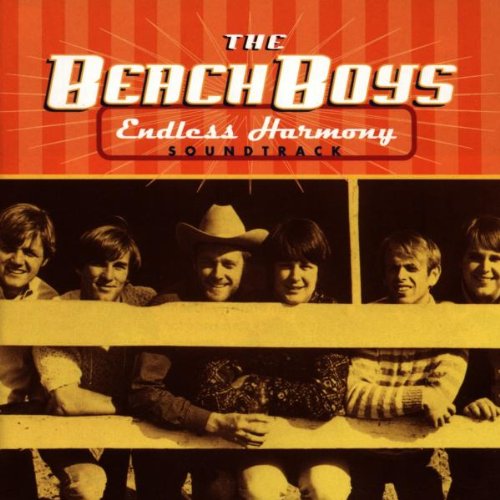
28. Endless Harmony (1998)
Dave Roberts: Multiple gems reside on this compilation: “Soulful Old Man Sunshine” was recorded at the beginning of the Sunflower sessions, Carl’s beautiful live rendition of “God Only Knows”, another sublime Dennis song with “Barbara”, a very cool alternate mix of “‘Til I Die”, and much more.
This album makes a fine bridge to the Smile Sessions.
Carl was only 15 years old when “Surfin’ Safari” topped the charts in 1962. He was the best musician in the band and when Brian turned to the Wrecking Crew for backing tracks, Carl was usually the only Beach Boy who played on the sessions. When Brian quit touring at the beginning 1965, Carl became the onstage band leader – and when Brian retreated from the studio, Carl became de-facto producer on 20/20, Sunflower, Surf’s Up, So Tough and Holland. All before the age of 26.
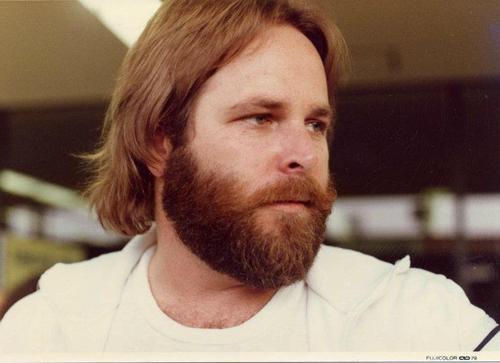
His angelic voice and soulful bearing never wavered. After being diagnosed with lung cancer in early 1997, Carl continued to tour and share his love of music. Throughout that last summer and fall, he performed from a stool with a much needed tank of oxygen at his side. But when time came for his solo turn on “God Only Knows”, Carl would stand at the microphone and his emotionally compelling voice would ring crystalline clear.
That wonderful, spiritual voice.
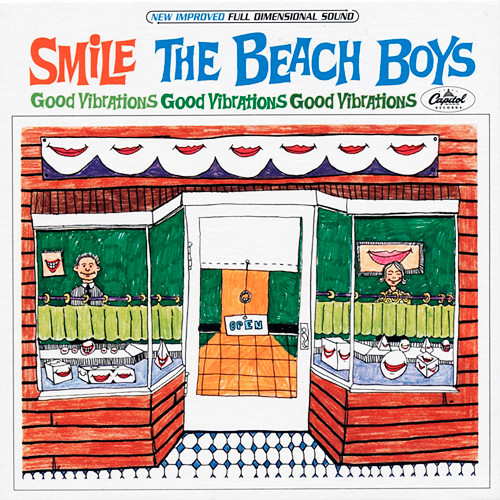
29. The Smile Sessions (2011)
Dave Roberts: Where do we start? Fragments and backing tracks of Smile have been used by the Beach Boys since the late-sixties. In 1993, the Good Vibrations box set gathered 10 extended Smile takes. Brian’s terrific re-imagining of Smile in 2004 finally gave us a clear-cut path to follow, and now with the Smile Sessions, we’re as close as we’ll ever get to what might have been.
The legend of Smile will always endure. The “Good Vibrations” single was an artistic and commercial triumph at the end of 1966. The Beatles’ “Penny Lane/Strawberry Fields” single was released in early 1967 to everyone’s astonishment.
Both singles pointed to a new, exciting direction. Smile was slated for an April ’67 release but it was not to be. Sgt. Pepper came out in June ’67, and blew everyone away. I still find it amazing that the top two bands in the world were working on these iconic albums at the exact same time.
And 44 years later, Brian’s Symphony has finally been realized.
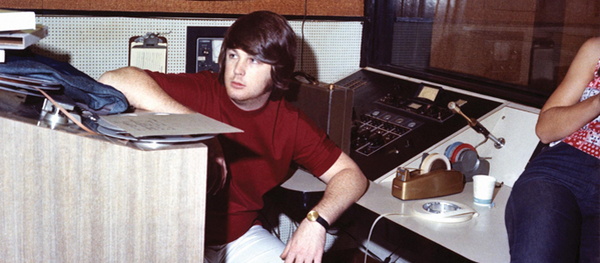
Special Thanks: Dave Roberts, Jon Springer, Uncle Wayne, user CY*, RG and others.

Comments
yckmd_
April 9, 2015
sheiscourtney Specifically, Giamatti as Landry sounds like a great casting choice.
yckmd_
April 9, 2015
sheiscourtney Looking forward to seeing it!
sheiscourtney
April 9, 2015
yckmd_ It’s also weirder than what it shows in the trailer. Definitely has more of a tortured artist angle.
sheiscourtney
April 9, 2015
yckmd_ it’s different from what I was expecting it would be, and it has flaws, but the performances were pretty stellar.
yckmd_
April 8, 2015
sheiscourtney I did not – I was unsure about the trailer when I saw it. That good? I’ll have to see it.
sheiscourtney
April 8, 2015
yckmd_ Did you catch Love & Mercy at TIFF? So good!